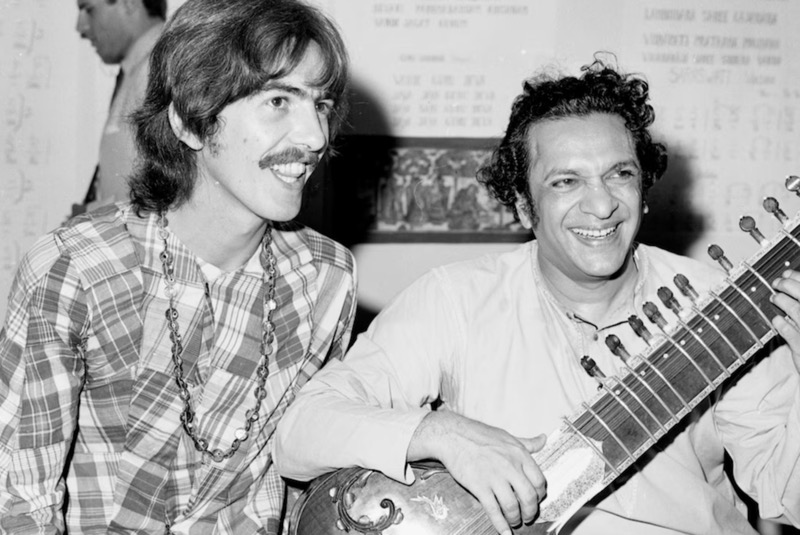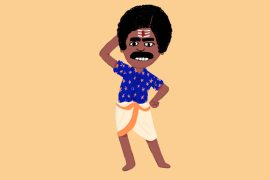The Sitar is one of the most popular instruments in the world. The stringed instrument, popularised globally by two of the greatest artists from the East and the West—Pandit Ravi Shankar and George Harrison—has become a symbol of fusion music and signifies the confluence of cultures.
Though the Sitar has its roots in the Indian sub-continent, the melodic notes from its strings found a home in the American pop culture of the 1960s and are now deeply embedded in the global music ensemble. But the stories surrounding its origins, narrated from the distant past, vaguely indicate how it evolved as one of the most sought-after musical instruments in the world.
Some historians argue that the famous singer and poet Amir Khusro invented the Sitar in the thirteenth century. As the story goes, Khusro, known for his penchant for alcohol and women, took three strings, fixed them to a piece of Wood that was the shape of the Sitar we see today, and called it ‘seh-tar’ or three strings. Later, as time passed by, the Seh-tar evolved into the Sitar.
However, unfortunately, the theory that Amir Khusro invented Sitar has been proven wrong because similar instruments like ‘tritantri’ (three-stringed instrument) and ‘saptantri’ (seven-stringed instrument) existed much before Khusro. Moreover, the Sitar has seven strings. However, it is generally accepted that Khusro popularised Sitar.
Another theory suggests that the Sitar is an offshoot of the Rudra veena, a musical instrument believed to have been created by Lord Shiva as a tribute to the beauty of his wife, Parvati. It is said that the Rudra veena can ‘purify‘ the minds of the listeners and musicians.
However, there is a problem with this theory. Historically, the Rudra veena has been around since the fifth century CE, but the veena is not so similar to the Sitar. The veena has a stick zither, while the Sitar has a lute. The materials used are also very different. And so, it is unlikely that the Sitar originated from the Rudra veena.
A more plausible theory suggests that the Sitar we see today was developed towards the end of the Mughal era, meaning it is relatively recent. It is said that a certain Amir Khusro — different from the one in the thirteenth century — invented the Sitar in the eighteenth century.
This theory has some merit to it. Khusro’s son, Masit Khan, did pioneering work on the Sitar by using the dhrupad style in his compositions; he is well-known for creating Masitkhani Gat. Bahadur Khan, the son of Masit Khan, further worked to popularise Masitkhani Gat: another sitar player, Ghulam Raza Khan, composed and popularised melodic tunes on the Sitar.
Many sitar players came and went after it was invented. But no one worked as hard as Ravi Shankar to popularise the instrument. Ravi Shankar trained under the sitar maestro Allaudin Khan for years. After completing his training, Khan offered his daughter Annapurna’s hand in marriage for Shankar.
Ravi Shankar was the cultural ambassador for Jawaharlal Nehru. Later, he composed the soundtrack of Pather Panchali by Satyajit Ray. From there, he went on to deliver many soundtracks during his career. Shankar’s career mainly took a turn after meeting George Harrison from The Beatles.
Ravi Shankar did his best to take Sitar to the world in the 1950s. In this endeavour, he visited the Soviet Union, Europe, and the U.S. and performed wherever possible. When he met George Harrison, the Beatles were already very famous. It wasn’t Ravi Shankar who met Harrison, but Harrison who met Ravi. At the time, Harrison was already a fan of the Sitar, so meeting Ravi Shankar was only a matter of time.
After they met, they hit it off rather quickly. George Harrison used the sounds of the Sitar in Norwegian Wood, a song that inspired Haruki Murakami to write a book of the same name. Shankar’s association with Harrison made him an instant star in the West, particularly in the U.S.
But it had an adverse effect back home. Indians thought that since Ravi Shankar was hanging around with ‘weed-smoking hippies,’ he too was a weed-smoking hippie. This, however, was not true, and Ravi Shankar himself was quite hurt by the assumption. Nevertheless, George Harrison and Ravi Shankar kept up the good work.
The journey of the Sitar did not stop with the Beatles. The instrument can also be heard in the songs of The Doors and Rolling Stones. Jim Morrison of The Doors, who was particularly fond of Indian instruments, used them in the scales of their instruments. The Rolling Stones have a song with Sitar as background, called Paint it Black. The song was a colossal hit and stayed on the charts for a long time. Despite its huge success, Rolling Stones never again used the Sitar in their songs.
The influence of Sitar in the 60s American pop culture did not stop at bands. Solo artists have also ventured into this space. Elton John sparingly used the Sitar in his song,’ Holiday Inn’. Scott McKenzie used the instrument for his song ‘San Francisco (Be Sure To Wear Flowers in Your Hair)’.
No one would have ever thought that a classical Indian instrument would be so popular in the hippie culture of 60s America. It demonstrates that the beauty of musical instruments lies not in their function but in their ability to surpass genres.
-30-
Copyright©Madras Courier, All Rights Reserved. You may share using our article tools. Please don't cut articles from madrascourier.com and redistribute by email, post to the web, mobile phone or social media.Please send in your feed back and comments to [email protected]











